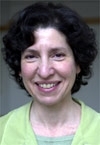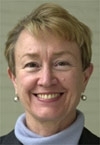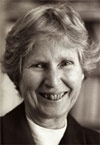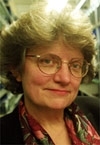Committees made up of women and men recently found that women professors had been marginalized in MIT's five schools, a pattern reported at many other universities and organizations after the release of the 1999 report on the School of Science.
The overview section of the just-released 2002 MIT report stated, "Outside MIT, the (1999) study ... resonated widely with professional women. The problems identified in the MIT report proved to be essentially universal for professional women in the United States.
"Further, the problem had frequently been ignored or misunderstood. President Vest held a conference of nine university presidents to discuss these issues, and the presidents made a commitment to address gender bias at their own schools."
Below is a brief summary of the reports on each of the schools. The report is available here. A news release summary is here.
ARCHITECTURE
Terry Knight, associate dean of the School of Architecture and Planning, chaired the committee studying women faculty in that school.
A number of women faculty reported feeling a lack of influence in important decision making, in contrast to some of their male colleagues, who reported great influence and inclusion in decision making. The percentage of women faculty is low relative to the number of women in the 'pipeline' for academic positions in architecture and planning, due in part to low rates of tenure for women in the school.
Dean William J. Mitchell noted, "Despite the considerable efforts that have been made to improve the situation of women faculty in our school, and despite the encouraging progress that has been made in some areas, we still need to achieve some substantial improvements."
ENGINEERING
Lorna Gibson, the Matloula S. Salapatas Professor of Materials Science and Engineering, chaired the committee assessing women faculty members' status.
Thomas L. Magnanti, dean of the School of Engineering, praised the committee for producing the report and urged the engineering community as a whole to meet its challenges. The report found that women faculty were hired in proportion to the available pipeline, but in some departments, the net gain in women faculty over near- ly a decade was conspicuously low.
"The strongest, most resilient human systems exhibit the highest degree of freedom, opportunity and diversity. For the sake of the engineering profession, for MIT's sake and, quite simply, because it is the right thing to do, we should and we must do better," he wrote in his statement.
Magnanti described some of the report as "heartening." He wrote, "MIT engineering has about 65 percent more women undergraduate students, 20 percent more women graduate students, and twice the fraction of women faculty as the national average.
"Women faculty performance is comparable to that of men (e.g. tenure rates, time to promotion, percentage of faculty with chairs). Women are compensated equally with men," he said.
He noted, however, that the "disturbing" aspects of the report added up to an "unacceptable" situation. These included the fact that the School of Engineering offered half as many jobs to women Ph.D.s from MIT as were offered to MIT male Ph.D.s and that many women candidates reject job offers from the school.
"In sum, we learn that there is bias and that MIT is not a hospitable environment for many women faculty," Magnanti said.
"Women need to have good reasons for coming to MIT's School of Engineering. To attract a higher percentage of women faculty, past gender inequities in pay and benefits still need to be adjusted; unequal teaching loads, committee participation and research project access must be addressed; and the strain on women when they're building a career and raising children should be acknowledged," the report stated.
HUMANITIES
Jean Jackson, professor of anthropology, and Deborah Fitzgerald, associate professor in science, technology and society, served as co-chairs of the committee on the School of Humanities, Arts and Social Sciences (SHASS).
The report noted that the school has the largest number of women faculty at the Institute and that, in respect to salary, "gender discrimination does not occur at present within any department."
Recommendations in the report on women in SHASS included improving mentoring of all incoming faculty and monitoring faculty salaries to recognize, in addition to scholarship, exceptional contributions in teaching, leadership and service to the Institute.
Dean Philip S. Khoury said the 2002 report provided "an important service. It has identified causes for optimism and causes for concern, and has put forth recommendations that will make this university a better place for all."
Khoury commented, "This is not cause for complacency. Comparative salary data hardly tell the full story. A significant number of senior women have been made to feel marginalized in their academic units and in the wider school and Institute. This finding is consistent with the findings in other MIT schools, and it is deeply troubling."
MANAGEMENT
The committee to study the status of women faculty in the Sloan School of Management was chaired by Lotte Bailyn, the T. Wilson (1953) Professor of Management.
In the Sloan report, the committee wrote, "a startling manifestation of the consequences of marginalization was discovered. In 60 interviews with senior women faculty and a matched group of men, there was no single case where the woman reported a better experience than did her matched male pair. And there were 40 comparisons where the man's reported experience was more positive than that of his matched pair."
Richard Schmalensee, the John C. Head III Dean of the MIT Sloan School of Management, said, "This analysis makes it inescapably clear that in our culture, men and women faculty with outwardly very similar careers are, in effect, working at two different schools. The women are at a much less congenial and supportive Sloan than the men."
"At the Sloan School, we teach future leaders that diversity can strengthen any organization by bringing more perspectives into deliberation and decision-making processes ... As scholars interested in improving organizational performance, we condemn glass ceilings and other forms of discrimination, but the data make it clear that ... as a society we have a long way to go before women are fully equal in the workplace. Now, as people of conscience and as leaders, we must commit ourselves to the difficult but unavoidable task of changing that culture."
SCIENCE
The 1999 report in the School of Science, chaired by Nancy Hopkins, the Amgen Inc. Professor of Biology, was strongly supported by former Dean Robert J. Birgeneau, now the president of the University of Toronto.
The current dean, Robert J. Silbey, commented in the 2002 report, "The energy and commitment of our women faculty initiated fundamental changes in the School of Science. To honor their bravery and tenacity, we must pursue with equal energy and determination the unfinished agenda. We have a great deal to accomplish before true equality and equal treatment are achieved."
Silbey noted that in 2002, six women hold important administrative positions, including directors of labs or centers, in the School of Science. "Their voices are being heard," Silbey said. No women held such positions in 1994 when the study began,
The Committees on the Status of Women Faculty, along with the Council on Faculty Diversity and the MIT Council on Family and Work, will continue to monitor equity issues at the Institute.
A version of this article appeared in MIT Tech Talk on March 20, 2002.











